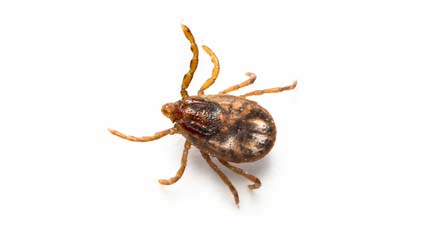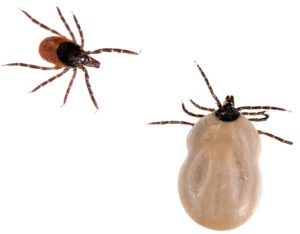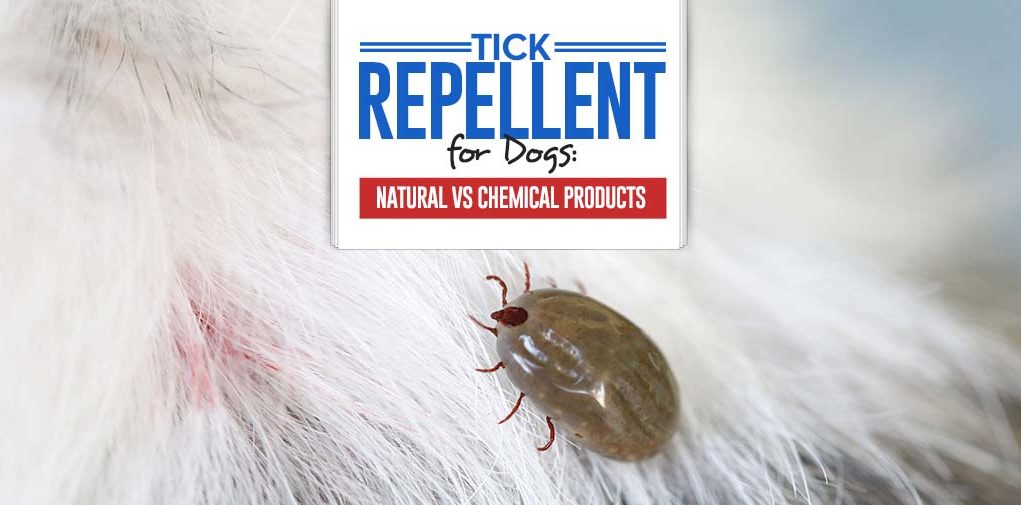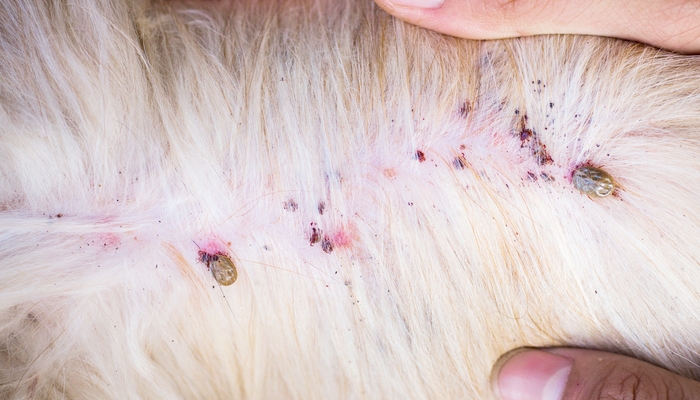Table of Contents
Ticks suck! Literally. Sadly, your dog is defenseless against these parasites, leaving you as their only protection from ticks and various tick-borne diseases. This is why dog owners should always have tick repellent for dogs on hand. But how much do you know about a dog tick repellent?
Before we look at the pros and cons of chemical products versus natural tick repellents for dogs, let’s inspect the workings of ticks a little closer. Did you know that each of a tick's eight legs is covered in short, spiky hairs and has a tiny claw at the end? This helps the tick to grip blades of grass, leaves, branches, and other vegetation.
This is what ticks look like up close:

Those spiky legs of ticks help them latch on to the unsuspecting host animal (in this case, it's your dog) before using their mouthparts to pierce the skin and suck the dog's blood. Some ticks, especially females, become completely engorged when full of blood.
A tick's method of feeding makes it the perfect disease vector. Ticks are responsible for more than ten different types of known diseases in the US, including:
- Babesiosis
- Tularemia
- Bourbon virus
- Lyme disease
The scary part is that there are no vaccines available for all the tick-borne disease your pet can get, and that is why it's important to use the best tick repellent for dogs. Most pet owners don't want to use just anything on their pet. They want to be sure they've done their research before committing to a safe and effective product.
Obviously, if you're reading this article, you're one of those pet owners – and that's a good thing! You should be wary of any dog tick repellent that you use with your pet. Let's see if we can help make your decision on choosing the best tick repellent for dogs a little easier.
RELATED: The Ultimate Dog Fleas and Ticks Survival Guide
Tick Repellent for Dogs
Everything you should know about these products
Safety First: Chemical or Natural Tick Repellent for Dogs?
Due to how dangerous ticks are for both dogs and humans, tick repellents for dogs have been extensively studied for several decades now (Dryden 2009). This research has brought forth valuable insight on the most safe and effective solutions. But how safe are these treatments for our pets?
A dog tick repellent may prevent ticks from coming in contact with your dog, or in the case they do latch on, it could hinder any feeding taking place. Most known dog tick repellents come with a large dose of different chemicals. So the million-dollar question is: are all these chemicals (that most people can't even pronounce) in vet-recommended products dangerous for your dog?
If you've done your own research, then you're aware that Google is a scary place. You will find mountains of evidence on the Internet stating the chemicals used in the most popular tick repellent for dogs are harsh and will cause cancer, nervous system failure, liver toxicity, kidney damage, convulsions, locomotor difficulty, and even death in dogs.
The list is a long and alarming one, and any dog owner's knee-jerk reaction will be to throw away anything from repellents to dog shampoo. But is it really that dangerous?
According to more recent studies (Halos et al. 2012 and Abdel-Ghaffar et al. 2015), there are many factors to keep in mind when considering which type of dog tick repellent to use on your canine. Products are broken down into three classes:
FDA-registered dog tick repellents – The safety and efficacy of these drugs have been closely studied, and their doses have been calculated to maximize safety and minimize any chances of adverse side effects for our pets.
EPA-registered products – these are considered “pesticides” and are available over-the-counter, without a prescription. They are generally safe and effective when used as advised on the label but not necessarily when used for different purposes, for example, on a cat instead of a dog.
Unregistered products – Natural tick repellent for dogs products generally fall under unregistered products and contain ingredients that are considered by the EPA to be of “minimal risk” and are therefore unregulated. It is important to note that the EPA's concern is primarily for human safety and other species might respond differently. These products have also only been evaluated for safety and not efficacy.
The concern here, therefore, is two-fold:
1) while natural dog tick repellent may not contain some of the chemicals from known brands, it also hasn't gone through rigorous testing to prove both its safety and efficacy;
2) and speaking of efficacy, since there are almost no studies using natural tick repellent for dogs products, most of the statements about them are coming from anecdotal evidence.
With FDA and EPA products, we've seen tons of studies on how effective and safe the compounds within those products are. Some of the two most popular treatments, fluranel from Bravecto and fipronil by Frontline have been also tested side-by-side in a randomized, blinded, controlled and multi-centered field study (Rohdich et al. 2014). Both have been effective and safe for dogs, with some advantage to fluranel.
REVIEW: Amber Crown Natural Flea and Tick Collars Review
Efficacy: Do Natural Tick Repellents for Dogs Work?
Unfortunately, nobody can say for sure until we've had some good evidence to prove one way or the other. After scouring tons of journals, I wasn't able to find any. So when it comes to natural tick repellent for dogs, there isn't that much to go by other than the opinions of other pet owners and some anecdotal evidence. Let's take a closer look at natural dog tick repellents and what some pet owners and holistic vets suggest.
There are as many natural remedies for ticks as there are alleged dangerous side effects of chemical dog tick repellents. But are they safe? Some sources list the following natural essential oils and related compounds that could work as tick repellents but could also possibly harm your dog if not used right:
Pyrethrins are a group of botanical insecticides that work by altering nerve function in insects, eventually resulting in the death of the parasite.
Pyrethroids are safe for dogs but highly toxic to cats.
Citronella is registered by the EPA as an insect-repellent, but has the potential to be a skin and eye irritant, and may be mildly toxic if ingested or inhaled. It would also have to be applied daily.
Garlic can have a toxic effect on dogs, but anecdotal evidence suggests that no more than one clove per 50 pounds of body weight is safe. There is no proof of this, however. The use of garlic as a tick or flea prevention in cats is not recommended.
Natural oils like lavender, peppermint, citrus, rose, basil, cinnamon, and lemongrass are said to be good tick repellent for dogs. It's a good idea to dilute these oils in water or a carrier oil like olive oil before spraying them on your dog. Dilute the oils in water and spray them on your dog's coat. Alternatively, you can mix the oils in with your dog's drinking water. Again, there's no evidence for this.
Some of the above natural products may or may not work as dog tick repellents, and they may or may not be safe. In general, the products most widely recommended by vets are the safest and most effective if you decide to go the route of “recommendation” and stir clear of already known FDA or EPA-registered products.
The Bottom Line
If you are one of the lucky ones who've had great success with using natural remedies to combat ticks, it's great news. If not, it is a good idea, with your vet's guidance, to find a product that can be safe for dogs.
Because of the thin line we're walking on here, we must weigh the risks and the benefits, and take it from there. The bottom line is that at this point in time, there is no concrete evidence that chemical tick repellent for dogs cause cancer or are otherwise dangerous, yet there is evidence that they are safe as the above studies indicate. Previous research has also confirmed their efficacy and safety (Bonneau et al., 2010).
Resistance to tick repellent for dogs is also extremely rare and is usually incorrectly reported by dog owners (Coles et al. 2014). Furthermore, these products also do not appear on the ASPCA Animal Poison Control Centers list of poisonous substances.
It's good to note that many tick repellent for dogs products do not generally kill ticks, but protect the treated dog. If you live in an area overrun with ticks, it is a good idea to look for a pesticide that is safe for you and your dog to reduce the tick population in your area.
Topical tick repellents aren't your only choice, either. You can also purchase tick collars, sprays, powders, and dips as repellents (for both ticks and fleas). The drawback to these is that they need to be reapplied often.
RELATED: 3 Best Flea and Tick Treatments Compared – Frontline vs. Seresto vs. Vet's Best
What else can you do?
Using tick repellent for dogs isn't the only thing that you can do to reduce the likelihood of these little buggers hitching a ride on your pet. Other things to consider include:
- keep your home dry and clean
- trim tall grass and clean up any leaf litter
- check yourself and your pet thoroughly for any ticks after spending time outside
What if my dog gets a tick?
 If you do find a tick on your dog, don't panic. Your first priority is to get the tick off your dog. If you don't feel comfortable attempting removal yourself, take your dog to the vet. For those living in a tick-dense area, rushing to the vet every time your dog has a tick will be a costly affair.
If you do find a tick on your dog, don't panic. Your first priority is to get the tick off your dog. If you don't feel comfortable attempting removal yourself, take your dog to the vet. For those living in a tick-dense area, rushing to the vet every time your dog has a tick will be a costly affair.
To do it yourself, take a pair of tweezers in a gloved hand and grasp the tick. Pull backward, but be sure to do it slowly and gently. If you pull too hard there is a possibility that the tick's head will break off still attached to your dog. This can lead to infection.
If you pull backward slowly, the tick will eventually release its bite. A specialized tick-removal tool might be a good investment if you are unsure how to remove a tick yourself.
Do not use matches, gasoline or anything of the sort to encourage the tick to drop off, as this will likely cause the tick to regurgitate inside your dog, increasing the risk of disease.
Remember, tick-borne disease in dogs may not appear for up to 21 days or longer after the initial bite. Keep a close eye on your dog and check for any changes in behavior or loss of appetite for at least 3 weeks. Also, continue to monitor the site of the tick bite, and take your pet to the vet if you notice any extreme redness or swelling.
In Summary
 As the above evidence shows, chemical tick repellent for dogs products are effective and safe for canines. They do not cause cancer or other health issues. Natural dog tick repellent products and solutions may or may not work, and we are yet to see any evidence to sway us either way.
As the above evidence shows, chemical tick repellent for dogs products are effective and safe for canines. They do not cause cancer or other health issues. Natural dog tick repellent products and solutions may or may not work, and we are yet to see any evidence to sway us either way.
Talk to your veterinarian before using any tick repellent, natural or chemical. They are trained professionals and their advice will go a long way. One thing to keep in mind, regardless of the efficacy of the product, the pet may have an allergic reaction to chemical or natural tick repellent for dogs. After applying keep an eye on your pet to see if any skin irritation, vomiting, diarrhea or seizures occur. Small dogs tend to be most sensitive to these types of products.
Keep in mind that ticks are tenacious and harder to prevent than fleas. Even if you use dog tick repellents and/or pesticides, you may still find a tick on your pet, so always be on the lookout, especially after walks in long grass or other areas where ticks are known to wait for their hosts. If you need help removing a tick from the dog, read the guide below and watch our video.
READ NEXT: How To Remove A Tick From A Dog – Our Step-by-Step Guide
















